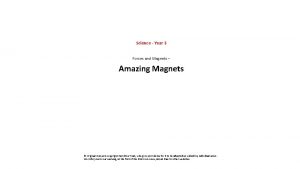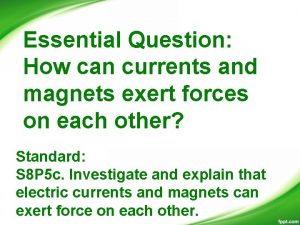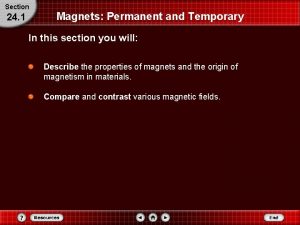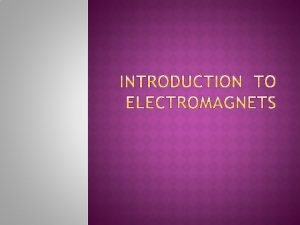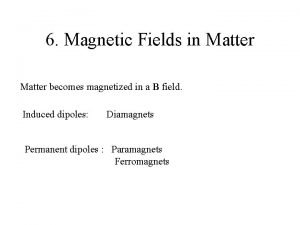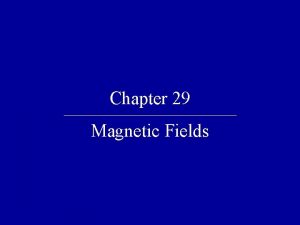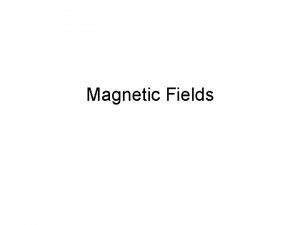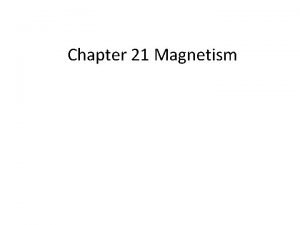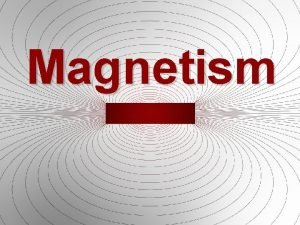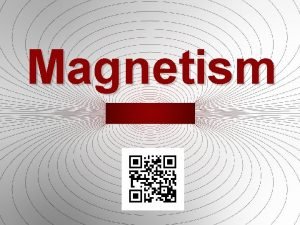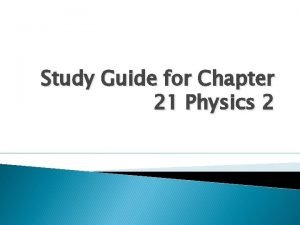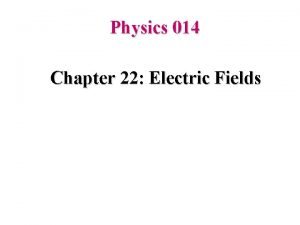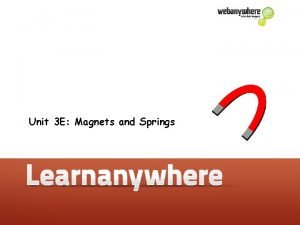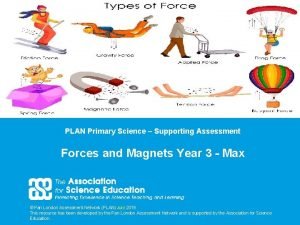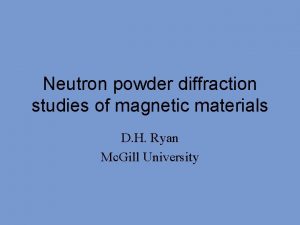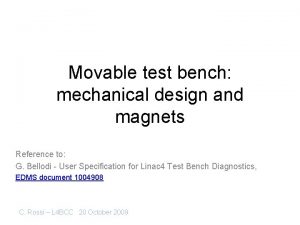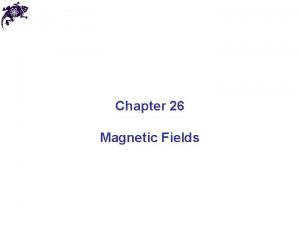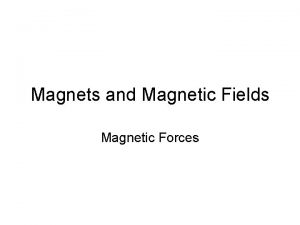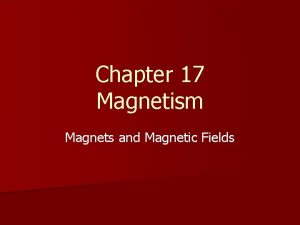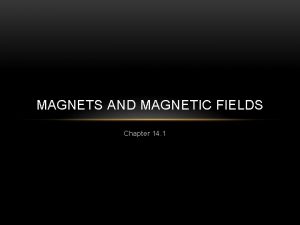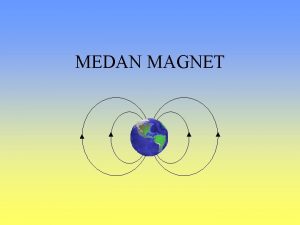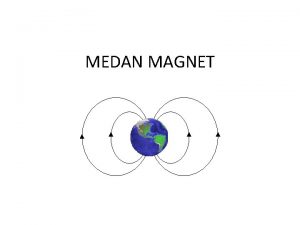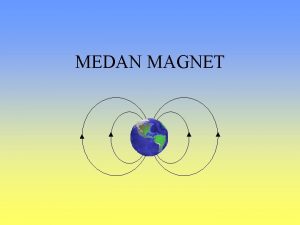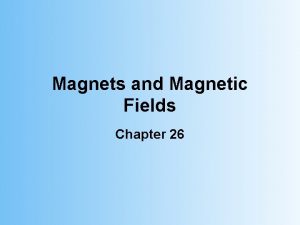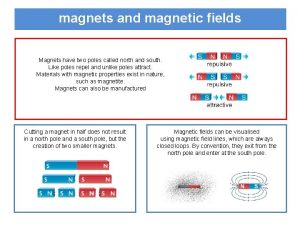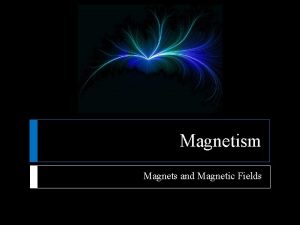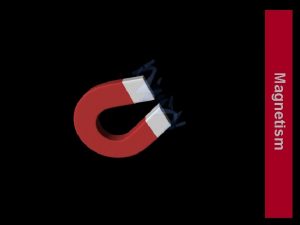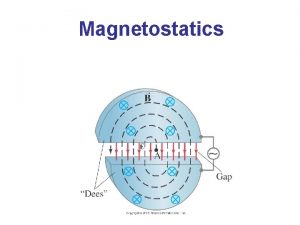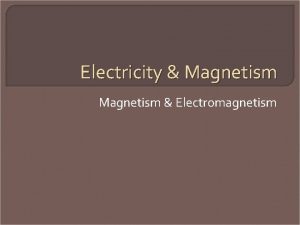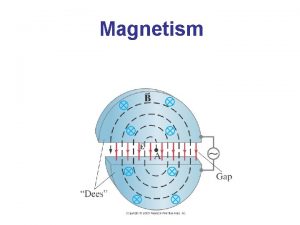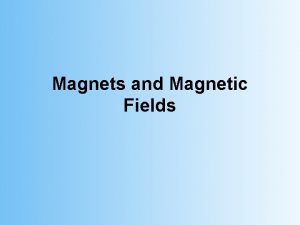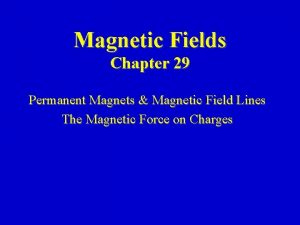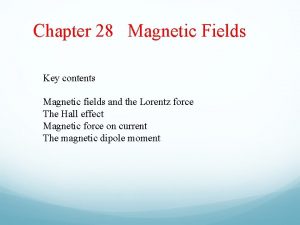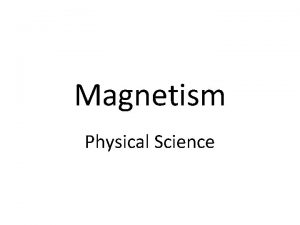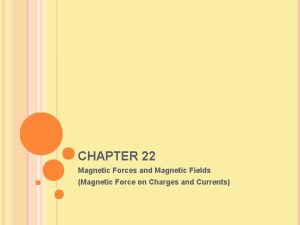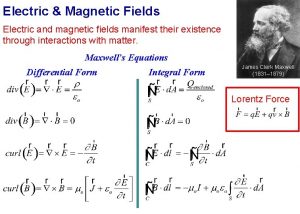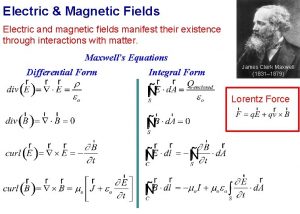Chapter 29 Magnetic Fields Magnets In each magnet






























- Slides: 30

Chapter 29 Magnetic Fields

Magnets • In each magnet there are two poles present (the ends where objects are most strongly attracted): north and south • Like (unlike) poles repel (attract) each other (similar to electric charges), and the force between two poles varies as the inverse square of the distance between them • Magnetic poles cannot be isolated – if a permanent magnetic is cut in half, you will still have a north and a south pole (unlike electric charges) • There is some theoretical basis for monopoles, but none have been detected

Magnets • The poles received their names due to the way a magnet behaves in the Earth’s magnetic field • If a bar magnet is suspended so that it can move freely, it will rotate • The magnetic north pole points toward the Earth’s north geographic pole • This means the Earth’s north geographic pole is a magnetic south pole • Similarly, the Earth’s south geographic pole is a magnetic north pole

Magnets • An unmagnetized piece of iron can be magnetized by stroking it with a magnet (like stroking an object to charge an object) • Magnetism can be induced – if a piece of iron, for example, is placed near a strong permanent magnet, it will become magnetized • Soft magnetic materials (such as iron) are easily magnetized and also tend to lose their magnetism easily • Hard magnetic materials (such as cobalt and nickel) are difficult to magnetize and they tend to retain their magnetism

Magnetic Fields • The region of space surrounding a moving charge includes a magnetic field (the charge will also be surrounded by an electric field) • A magnetic field surrounds a properly magnetized magnetic material • A magnetic field is a vector quantity symbolized by B • Its direction is given by the direction a north pole of a compass needle pointing in that location • Magnetic field lines can be used to show the field lines, as traced out by a compass, would look

Magnetic Field Lines • A compass can be used to show the direction of the magnetic field lines

Magnetic Field Lines • Iron filings can also be used to show the pattern of the magnetic field lines • The direction of the field is the direction a north pole would point • Unlike poles (compare to the electric field produced by an electric dipole)

Magnetic Field Lines • Iron filings can also be used to show the pattern of the magnetic field lines • The direction of the field is the direction a north pole would point • Unlike poles (compare to the electric field produced by an electric dipole) • Like poles (compare to the electric field produced by like charges)

Magnetic Fields • When moving through a magnetic field, a charged Nikola Tesla particle experiences a magnetic force 1856 – 1943 • This force has a maximum (zero) value when the charge moves perpendicularly to (along) the magnetic field lines • Magnetic field is defined in terms of the magnetic force exerted on a test charge moving in the field with velocity v • The SI unit: Tesla (T)

Magnetic Fields • Conventional laboratory magnets: ~ 2. 5 T • Superconducting magnets ~ 30 T • Earth’s magnetic field ~ 5 x 10 -5 T

Direction of Magnetic Force • Experiments show that the direction of the magnetic force is always perpendicular to both v and B • Fmax occurs when v is perpendicular to B and F = 0 when v is parallel to B • Right Hand Rule #1 (for a + charge): Place your fingers in the direction of v and curl the fingers in the direction of B – your thumb points in the direction of F • If the charge is negative, the force points in the opposite direction

Direction of Magnetic Force • The x’s indicate the magnetic field when it is directed into the page (the x represents the tail of the arrow) • The dots would be used to represent the field directed out of the page (the • represents the head of the arrow)

Differences Between Electric and Magnetic Fields • The electric force acts along the direction of the electric field, whereas the magnetic force acts perpendicular to the magnetic field • The electric force acts on a charged particle regardless of whether the particle is moving, while the magnetic force acts on a charged particle only when the particle is in motion • The electric force does work in displacing a charged particle, whereas the magnetic force associated with a steady magnetic field does no work when a particle is displaced (because the force is perpendicular to the displacement)

Force on a Charged Particle in a Magnetic Field • Consider a particle moving in an external magnetic field so that its velocity is perpendicular to the field • The force is always directed toward the center of the circular path • The magnetic force causes a centripetal acceleration, changing the direction of the velocity of the particle

Force on a Charged Particle in a Magnetic Field • This expression is known as the cyclotron equation • r is proportional to the momentum of the particle and inversely proportional to the magnetic field • If the particle’s velocity is not perpendicular to the field, the path followed by the particle is a spiral (helix)

Chapter 29 Problem 3 A proton moves perpendicularly to a uniform magnetic field at 1. 0 × 107 m/s and exhibits an acceleration of 2. 0 × 1013 m/s 2 in the +x-direction when its velocity is in the +zdirection. Determine the magnitude and direction of the field.

Chapter 29 Problem 15 A cosmic-ray proton in interstellar space has an energy of 10. 0 Me. V and executes a circular orbit having a radius equal to that of Mercury’s orbit around the Sun (5. 80 × 1010 m). What is the magnetic field in that region of space?

Particle in a Nonuniform Magnetic Field • The motion is complex

Charged Particles Moving in Electric and Magnetic Fields • In many applications, charged particles move in the presence of both magnetic and electric fields • In that case, the total force is the sum of the forces due to the individual fields:

Magnetic Force on a Current Carrying Wire • The current is a collection of many charged particles in motion • The magnetic force is exerted on each moving charge in the wire • The total force is the sum of all the magnetic forces on all the individual charges producing the current • Therefore a force is exerted on a currentcarrying wire placed in a magnetic field:

Magnetic Force on a Current Carrying Wire • The direction of the force is given by right hand rule #1, placing your fingers in the direction of I instead of v

Chapter 29 Problem 25 A wire having a mass per unit length of 0. 500 g/cm carries a 2. 00 -A current horizontally to the south. What are the direction and magnitude of the minimum magnetic field needed to lift this wire vertically upward?

Magnetic Force on a Current Carrying Wire of an Arbitrary Shape • For a small segment of the wire, the force exerted on this segment is • The total force is

Torque on a Current Loop

Torque on a Current Loop • Applies to any shape loop • Torque has a maximum value when q = 90° • Torque is zero when the field is perpendicular to the plane of the loop

Magnetic Moment • The vector is called the magnetic dipole moment of the coil • Its magnitude is given by μ = IAN • The vector always points perpendicular to the plane of the loop(s) • The equation for the magnetic torque can be written as τ = BIAN sinθ = μB sinθ • The angle is between the moment and the field

Potential Energy • The potential energy of the system of a magnetic dipole in a magnetic field depends on the orientation of the dipole in the magnetic field • Umin = – μB and occurs when the dipole moment is in the same direction as the field • Umax = + μB and occurs when the dipole moment is in the direction opposite the field

Chapter 29 Problem 38 A wire is formed into a circle having a diameter of 10. 0 cm and placed in a uniform magnetic field of 3. 00 m. T. The wire carries a current of 5. 00 A. Find (a) the maximum torque on the wire and (b) the range of potential energies of the wire-field system for different orientations of the circle.

Answers to Even Numbered Problems Chapter 29: Problem 4 (a) 86. 7 f. N (b) 51. 9 Tm/s 2

Answers to Even Numbered Problems Chapter 29: Problem 46 39. 2 m. T
 Magnetism lesson outline answer key
Magnetism lesson outline answer key Magnets attract and repel
Magnets attract and repel Electromagnetic application
Electromagnetic application Red fields
Red fields Explain how currents and magnets exert forces on each other
Explain how currents and magnets exert forces on each other Which diagram shows magnets that will attract each other?
Which diagram shows magnets that will attract each other? What happens if you break a magnet in half
What happens if you break a magnet in half Are electromagnets permanent or temporary
Are electromagnets permanent or temporary Cara membuat magnet permanen
Cara membuat magnet permanen Learning: module 26: magnetic forces and fields
Learning: module 26: magnetic forces and fields Magnetic fields in matter
Magnetic fields in matter Lesson quiz 29-1
Lesson quiz 29-1 Electric currents and magnetic fields
Electric currents and magnetic fields Electric currents and magnetic fields
Electric currents and magnetic fields Cow magnet magnetic field lines
Cow magnet magnetic field lines The magnetic field that surrounds a magnet exerts
The magnetic field that surrounds a magnet exerts Horseshoe magnet magnetic field
Horseshoe magnet magnetic field Remanent magnetization
Remanent magnetization Wb magnetic flux
Wb magnetic flux Magnetic moment and magnetic field relation
Magnetic moment and magnetic field relation Force on charged particle
Force on charged particle Magnetic field lines that curve away from each other show
Magnetic field lines that curve away from each other show Chapter 16: electric forces and fields answers
Chapter 16: electric forces and fields answers Chapter 33 electric fields and potential
Chapter 33 electric fields and potential Chapter 21 study guide electric fields answers
Chapter 21 study guide electric fields answers Electric field for a disk
Electric field for a disk Magnets for year 3
Magnets for year 3 Magnets and springs
Magnets and springs Why do magnets repel
Why do magnets repel Magnets for neutron diffraction
Magnets for neutron diffraction Amazing magnets
Amazing magnets

